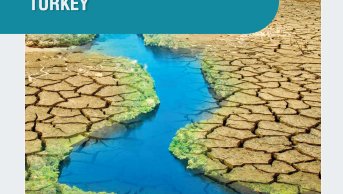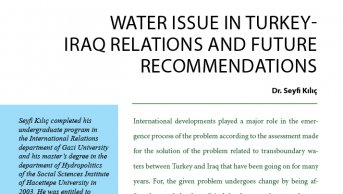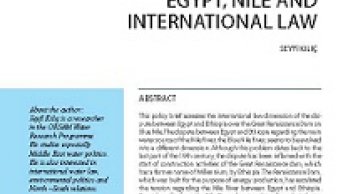Manmade Deprivation: Water and Sanitation in Gaza

In addition to the political split in Palestine that has been around since 2007, the country has been geographically divided into two parts since the establishment of the State of Israel in 1948. Considering the situation in the Gaza Strip, the water crisis Palestinians face in the West Bank is quite understandable. The water resources in the Gaza Strip are limited. There are 1.7 million people living in Gaza, where annual renewable water resources total 65 million cubic meters and the total area is 365 square kilometers. It should be noted that 1.1 million of these people are refugees who live in camps.
Considering that the population of Gaza was 50,000 in 1948, when the State of Israel was established and the Arab-Israeli War took place, one can easily imagine the pressure on natural resources caused by the forced displacement of Palestinians in 1948 that accompanied the establishment of the State of Israel. As in the West Bank, Israel started to send Israeli settlers to the Gaza Strip after occupation in 1967. The settlers stayed there for 38 years, until 2005. The amount of water consumed by some 3,500 settlers in a year reached 6 million cubic meters. Considering that 1.7 million Palestinians consume 100 million cubic meters of water per year, Israel's exploitation through occupation in the Gaza Strip, where natural resources are already scarce, is clear. The level of the groundwater aquifer in the Gaza Strip decreases by 15-20 centimeters per year due to the overpumping of groundwater, and it has become further salinized due to seawater intrusion.
The main source of water in the Gaza Strip is the groundwater resource, which is located along the Israeli coast and is called the Coastal Aquifer. The renewable yield of this resource is 55-65 million cubic meters per year. However, the Gaza Strip is one of the most densely populated areas of the world. Despite the total area of Gaza being 365 square kilometers, the 1.7 million residents of the area impact all environmental resources. In the Gaza Strip, where 68 percent of the total population are refugees and 79 percent are below the poverty line (less than $2 a day), according to the United Nations Development Programme (UNDP), one cannot expect properly working public services.
A great number of human-related disasters have taken place throughout history. One big example of this is the manmade environmental crisis that took place on Easter Island. Life on the island, which was about to end as a result of the island's resources being used up by locals and also due to the consequences of overpopulation, took a final blow with the arrival of the Europeans. The Gaza Strip has been going through a similar situation in the 21st century. A dense population stuck in a small area with no connection to the outside world is the modern example of that disaster that took place on Easter Island centuries ago. The long-term Israeli occupation of the area and the imposition of an intensified blockade on Gaza -- on the pretext that Hamas had taken control -- worsened the humanitarian situation. In addition to Israel, Egypt also oppresses the Gaza Strip. Egypt's policy of pressure on the area was launched during the Hosni Mubarak period, was pursued during the Mohammed Morsi presidency -- he was ousted by a coup d'état -- and continues to be implemented by the current Egyptian administration. As a result of this double pressure, it has become almost impossible for the Gaza population to meet basic needs like water, sanitation and electricity in the Gaza Strip. In addition to the embargo policy, the attacks carried out by Israel further bring the situation in the Gaza Strip into deadlock.
Especially during the Israeli attack that started on Dec. 27, 2008, and that lasted until Jan. 18, 2009, all kinds of infrastructure across the Gaza Strip were targeted, and more than 1,500 people were killed. During the Israeli attacks, water conveyance pipelines and sewage systems, in addition to houses, shops, buildings and electric networks, were purposely targeted. The infrastructure, which was already insufficient, was destroyed as a result of these attacks. The ongoing embargo on construction materials is a big obstacle in particular to developing the infrastructure. Also, the recently increasing fuel problem poses an issue in terms of distributing water to households.
The floods that took place in Gaza last week and the damage caused by the floods should be assessed within the general framework mentioned above. To form an opinion on the issue based on the fact that the Disaster Response Committee affiliated with the Hamas government accused Israel of opening up dams and causing floods in the Gaza Strip would not be helpful in seeing the problem in its entirety. Israel is not only accused of opening up dams. It also did not abide by the responsibilities of an occupying state regulated by international law when it occupied the Gaza Strip between 1967 and 2005. Furthermore, it impeded all kinds of developments through the embargo it imposed afterwards.
“Technical” analyses, which could assess the aforementioned floods as a result of rainfall that had not been seen for a long time, will probably be brought to the agenda. However, even if the latest floods were explained by rainfall, there is no way to explain the sewage floods that took place in November. The wastewater flood in Gaza, which stemmed from a sewage pumping station that had been closed due to a diesel fuel problem in November, points out a structural problem. Although Israel is primarily responsible for this problem, Egypt's former and current administrations are also responsible. Besides that, the role of the Hamas administration, which did not buy diesel fuel from Israel, leading to the closure of the pumping station in order to deprive the Palestinian administration in Ramallah of tax revenue, is undeniable.
All parties, and especially the international community, have to strive greatly to remedy the general disaster in the Gaza Strip, which can be seen as the Easter Island of the 21st century. Efforts to lift the embargo imposed on the area should come first. Solving the Palestinian problem, including the recognition of the right for refugees to return to their homes, constitutes the basis for solving the humanitarian and environmental problem in the Gaza Strip.










